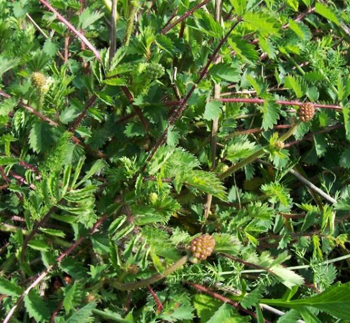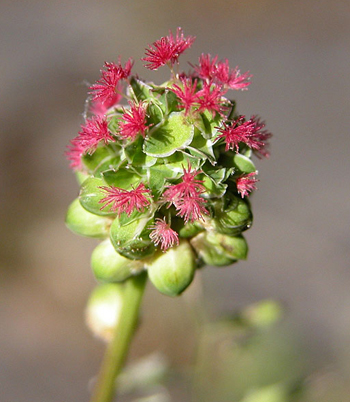Contents:
Common Names | Parts Usually Used | Plant(s) & Culture | Where Found | Medicinal Properties | Biochemical Information
Legends, Myths and Stories | Uses | Formulas or Dosages | Warning | Bibliography
Scientific Names

- Sanguisorba minor L.
- Sanguisorba officinalis L.
- Rosaceae
- Rose family
Common Names
- Bipulo
- Lady-smocks
- Pimpinella
- Salad burnet
- Sanguisorbia
- Solbegrella
Parts Usually Used
Leaves, root
Back to Top

Description of Plant(s) and Culture
Salad burnet is a bushy, perennial plant produces nearly evergreen, fernlike foliage; 1-2 feet tall, the leaves compound, leaflets 7-15, toothed. Tiny purplish red (almost crimson) flowers, in oval or thickly rounded heads; blooms May to October.
Back to Top
Where Found
Maine to Minnesota, escaped elsewhere, mostly cultivated in herb gardens.
The wild variety grows in England, especially in Huntingdon, Northamptonshire and near London. Dislikes high ground, preferring the moister soil of low, sheltered valleys.
Back to Top
Medicinal Properties
Astringent, styptic, febrifuge, hemostatic, alterative
Back to Top
Biochemical Information
Tannins, the leaves contain a sapanoside and flavones
Back to Top
Legends, Myths and Stories
Salad burnet has a nutty flavor that hints of cucumber, and is similar to borage in its taste and uses. Add to salads, cold drinks, soups, cream cheese, vinegar, or use as a garnish. Must use fresh leaves.
Makes a tea from fresh or dried leaves, served hot or cold; once was used to flavor wine. Said to be taken as protection of the Plague and other contagious diseases in Pliny’s day.
The botanical name (Latin sanguis = blood) refers to its ability to staunch bleeding of wounds.
Another species of burnet actually goes by the name of salad burnet (Potaerium sanguisorba).
Back to Top
Uses
Leaf tea used for fevers and as a styptic. American soldiers drank tea before battles in the Revolutionary War to prevent bleeding if they were wounded. Root tea stops menstrual bleeding, bleeding from piles, dysentery; externally, for sores, swelling, canker sores, ulcers, moist skin ailments, wounds, burns. Powdered root used for 2nd and 3rd degree burns.
Back to Top
Formulas or Dosages
Pound the leaves into pulp and spread on a clean piece of bandage or lint. Apply as a poultice.
Back to Top
Warning
Contains tannins, contraindicated for burns in Western medicine.
Back to Top
Bibliography
![]() The Complete Medicinal Herbal
The Complete Medicinal Herbal, by Penelope Ody, Dorling Kindersley, Inc, 232 Madison Avenue, New York, NY 10016, First American Edition, copyright 1993
![]() Country Home Book of Herbs
Country Home Book of Herbs, Meredith Books, Editorial Dept. RW240, 1716 Locust Street, Des Moines, IA 50309-3023, copyright 1994
![]() Culpeper’s Complete Herbal & English Physician: Updated With 117 Modern Herbs
Culpeper’s Complete Herbal & English Physician: Updated With 117 Modern Herbs, by Nicholas Culpeper, Meyerbooks, publisher, PO Box 427, Glenwood, Illinois 60425, 1990, (reprint of 1814)
![]() Eastern/Central Medicinal Plants
Eastern/Central Medicinal Plants, by Steven Foster and James A. Duke., Houghton Mifflin Company, 215 Park Avenue South, New York, NY 10000
![]() The Herb Book
The Herb Book, by John Lust, Bantam Books, 666 Fifth Avenue, New York, NY. copyright 1974.
![]() Indian Herbalogy of North America
Indian Herbalogy of North America, by Alma R. Hutchens, Shambala Publications, Inc., Horticultural Hall, 300 Massachusetts Avenue, Boston, Massachusetts 02115, 1973
 The Magic of Herbs
The Magic of Herbs, by David Conway, published by Jonathan Cape, Thirty Bedford Square, London, England. (Out of print)
![]() Planetary Herbology
Planetary Herbology, by Michael Tierra, C.A., N.D., O.M.D., Lotus Press, PO Box 325, Twin Lakes. WI 53181., Copyright 1988, published 1992
![]() Webster’s New World Dictionary
Webster’s New World Dictionary, Third College Edition, Victoria Neufeldt, Editor in Chief, New World Dictionaries: A Division of Simon & Schuster, Inc., 15 Columbus Circle, New York, NY 10023
 The Rodale Herb Book: How to Use, Grow, and Buy Nature’s Miracle Plants (An Organic gardening and farming book)
The Rodale Herb Book: How to Use, Grow, and Buy Nature’s Miracle Plants (An Organic gardening and farming book), edited by William H. Hylton, Rodale Press, Inc. Emmaus, PA, 18049., 1974
